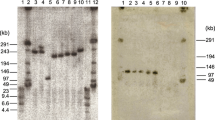Abstract
Natural hybrid zones are known to have unusually high levels of novel or otherwise rare electrophoretic variants (the “rare allele phenomenon”). These variant alleles are most likely the result either of high levels of unique mutations in hybrids or of intragenic recombination between divergent alleles from the parental populations. This study uses DNA sequence comparisons to determine which process has produced a rare allele of the 6-phosphogluconate dehydrogenase (6PGD) gene in a subspecific hybrid zone of the California field mouse (Peromyscus californicus).
About 70% of the coding sequence of 6-PGD was cloned and sequenced from three alleles, including two widespread alleles and one rare allele unique to hybrid populations. Sequence comparisons among the three alleles reveal no patterns that would indicate that the variant was formed by intragenic recombination. Instead, the unique allele of 6-PGD studied seems to have developed by the accumulation of base substitutions, which supports the hypothesis of increased mutation rates in hybrids.
Similar content being viewed by others
References
Barton NH, Halliday RB, Hewitt GM (1983) Rare electrophoretic variants in a hybrid zone. Heredity 50:139–146
Barton NH, Hewitt GM (1985) Analysis of hybrid zones. Annu Rev Ecol Syst 16:113–148
Blin N, Stafford DW (1976) A general method for the isolation of high molecular weight DNA from eukaryotes. Nucleic Acids Res 3: 2303–2308
Bradley RD, Bull JJ, Johnson AD, Hillis DM (1993) Origin of a novel allele in a mammalian hybrid zone. Proc Natl Acad Sci USA 90: 8939–8941
Carne A, Walker JE (1983) Amino acid sequence of ovine 6-phosphogluconate dehydrogenase. J Biol Chem 258:12895–12906
Dowling TE, Moore WS (1985) Genetic variation and divergence of the sibling pair of cyprinid fishes Notropis cornutus and N. chrysocephalus. Biochem Syst Ecol 13(4):471–476
Hoffman SMG (1991) The molecular mechanisms underlying the “rare allele phenomenon” in a subspecific hybrid zone of the California mouse, Peromyscus californicus. Unpublished PhD thesis, University of Michigan, Ann Arbor
Kass DK, Hoffman SMG (1993) Unusual patterns of susceptibility to degradation of DNA isolated from tissues in Peromyscus californicus. Lab Anim 27:273–277
Maniatis T, Fritsch EF, Sambrook J (1982) Molecular cloning: a laboratory manual. Cold Spring Harbor Laboratory Press, Cold Spring Harbor, NY
McCabe T, Blanchard B (1950) Three species of Peromyscus. Rood Assoc, Santa Barbara
Miksicek RJ, Towle HC (1983) Use of a cloned cDNA sequence to measure changes in 6-phosphogluconate dehydrogenase mRNA levels caused by thyroid hormone and dietary carbohydrate. J Biol Chem 258:9575–9579
Nelson K, Baker RJ, Honeycutt RL (1987) Mitochondrial DNA and protein differentiation between hybridizing cytotypes of the whitefooted mouse Peromyscus leucopus. Evolution 41:864–872
Sage RD, Selander RK (1979) Hybridization between species of the Rana pipiens complex in Central Texas. Evolution 33:1069–1088
Sanger F, Nicklen S, Coulson AR (1977) DNA sequencing with chain-termination inhibitors. Proc Natl Acad Sci USA 74:5463–5467
Schilthuizen M, Gittenberger E (1994) Parallel evolution of an sAat‘hybrizyme’ in hybrid zones in Albinaria hippolyti (Boettger). Heredity 73:244–248
Selander RK, Smith MH, Yang SY, Johnson WE, Gentry JB (1971) Biochemical polymorphism and systematics in the genus Peromyscus. 1. Variation in the old-field mouse (Peromyscus polionotus). Stud Genet VI, Univ Texas Publ 7103:49–90
Smith MF (1978) Relationships between genetic variability and niche dimensions among coexisting species of Peromyscus. Unpublished PhD thesis, University of California, Berkeley
Smith MF (1979) Geographic variation in genic and morphological characters in Peromyscus californicus. J Mamm 60:705–722
Woodruff DS (1989) Genetic anomalies associated with Cerion hybrid zones: the origin and maintenance of new electromorphic variants called hybrizymes. Biol J Linn Soc 36(3):281–294
Woodruff RC, Slatko BE, Thompson JN (1983) Factors affecting mutation rates in natural populations. In: Ashburner M, Carson HL, Thompson JN (eds) Genetics and biology of Drosophila: 3C. Academic Press, New York
Author information
Authors and Affiliations
Rights and permissions
About this article
Cite this article
Hoffman, S.M.G., Brown, W.M. The molecular mechanism underlying the “rare allele phenomenon” in a subspecific hybrid zone of the California field mouse, Peromyscus californicus . J Mol Evol 41, 1165–1169 (1995). https://doi.org/10.1007/BF00173198
Received:
Accepted:
Issue Date:
DOI: https://doi.org/10.1007/BF00173198




